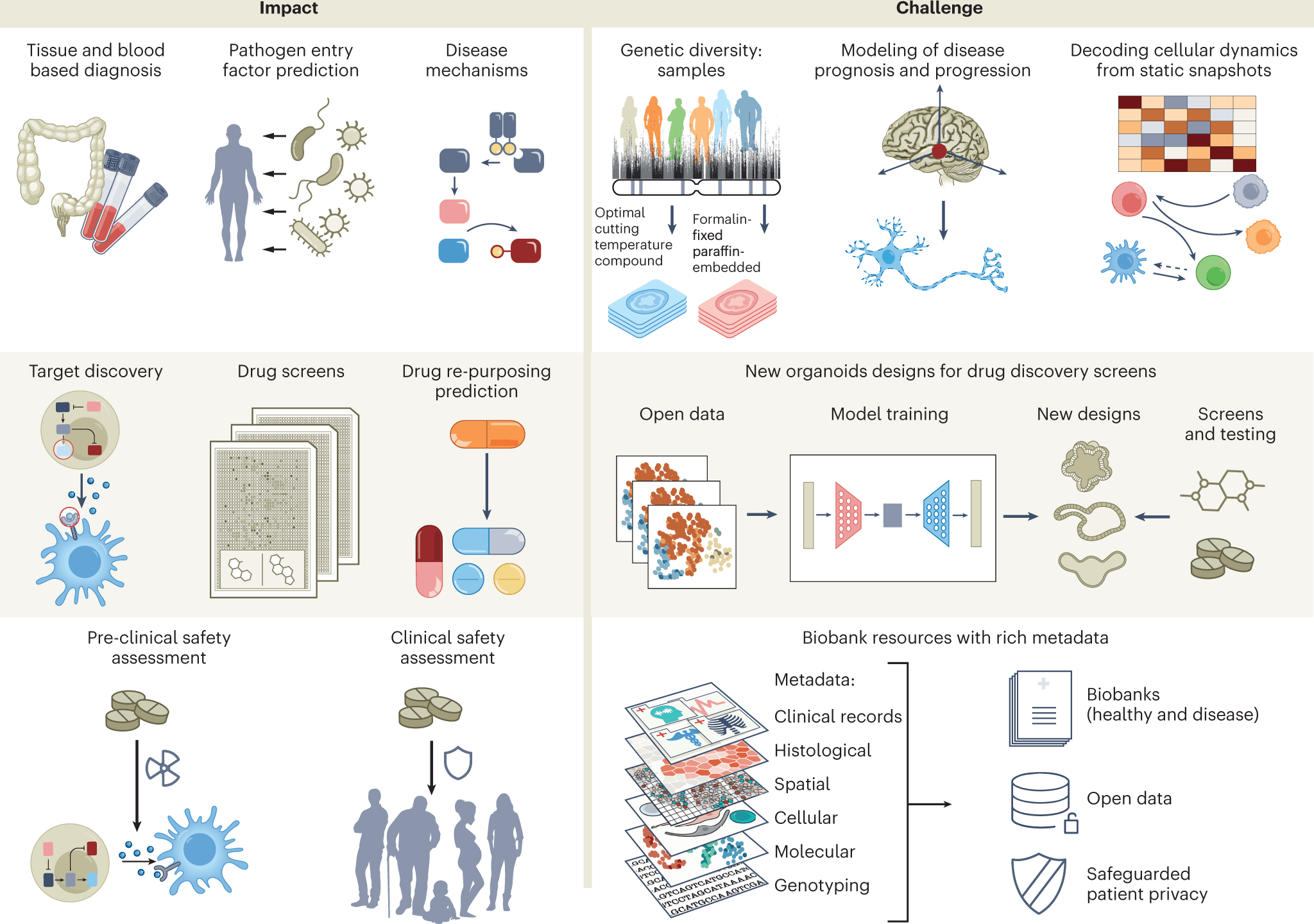In order to better understand human health and to identify, track, and cure diseases, the International Human Cell Atlas collaboration is building detailed reference maps of every human cell, which is life’s basic building block.

Image source: https://doi.org/10.1038/s41591-022-02104-7
The Human Cell Atlas aims to map every type of cell in the human body, revolutionizing how we understand biology and disease and possibly resulting in significant improvements in how diseases are identified and cured.
The molecular mechanisms of disease are viewed by addressing the kinds of cells, states, programs, and contexts in which they operate at the cellular and tissue levels. This understanding can be further employed to develop effective disease diagnostics, identify novel therapeutic drug targets, their therapeutic potential, toxicity, and resistance mechanisms, and enable new types of therapies, from cancer therapies to regenerative medicine.
A brief description of the potential of cell atlases to influence the field of medicine and how recent developments have started to realize this potential in the treatment of cancer, rare diseases, infectious diseases (including COVID-19), common complex diseases, and infectious diseases in general.
To grasp the etiology and identify and offer innovative remedies, there is a need to comprehend cells, their intrinsic pathways, and their interactions in health and sickness. Despite the fact that this has been understood for many years, technical obstacles have prevented us from concurrently probing human illness at a wide scale and with a high level of molecular and cellular detail.
Cell atlases offer a solution to each of these problems
Healthy tissue atlases have even resolved abiding beliefs in cases of uncommon Mendelian genetic diseases by revealing novel cell types, even rare ones, that express disease-related genes in a distinctive way.
Similar investigations employing both healthy and disease atlases of the appropriate tissue have linked disease genes in associated loci to particular cell subsets across various inflammatory, autoimmune, neurodegenerative, respiratory, fibrotic, and other disorders, uncovering new, unexpected connections.
Multicellular remodeling for efficient pathogenesis
Cell-intrinsic and cell-extrinsic changes play important roles in pathogenesis and can be targeted by therapeutics, although alterations in cellular composition and internal program modifications are frequently confused in bulk profiling.
Changes in the composition of multicellular communities can be brought about by both cell-intrinsic expression changes and the coordination of compositional changes across different cell types. In the ileum of Crohn’s disease patients, for instance, a distinctive multicellular population of immune and stromal cells was found to be indicative of a lack of response to an anti-TNF medication when compared to the healthy reference atlas. Understanding the processes governing these coordinated communities and the gene programs inside their constituent cells is also made easier by comparison with healthy references.
Plotting and tracing the biological complexity of malignant cells
Single-cell and spatial genomic atlases are also transforming our understanding of the biology of human cancer. The biological complexity of solid tumors can be visualized by comparing them to healthy references and analyzing the genetic and epigenetic variation within the malignant compartment, along with the diversity of cells in the tumor microenvironment, including immune, stroma, and even neural cells, and their spatial organization. This has aided in identifying pertinent disease mechanisms, appropriate intervention opportunities, and host defenses, such as cell communities that may envisage responses to treatments like checkpoint inhibitors or chemoradiation, as well as the cell of origin in both adult and pediatric tumors.
High-resolution cell and tissue diagnostics for drug discovery
The development of standard diagnostic methods, including single-cell tests like the complete blood count (CBC) and white blood cell count, as well as histopathology, should be influenced by our growing understanding of all cell types in the body and their involvement in disease. The creation of novel assays with greater resolution and a larger molecular scope, as well as enhanced interpretation of data from individual patients, should be possible thanks to the disease atlases, healthy reference atlases, and core lab and computational approaches.
Reference atlases and single-cell and spatial genomics, which couple the rich, complex, and interpretable phenotypes of molecular profiles, which can be attributed to cells in patients, to the scale necessary in screening, enable high-resolution phenotypic screens for desired cell states in molecular drug discovery. Single-cell atlases improve our capacity to identify regenerative pathways in human tissue as therapeutic targets, provide better organoid models for drug discovery, and define better-engineered cell treatments in the context of regenerative medicine and cell therapy.
Concerns in the medicinal arena
There are many obstacles to be addressed before cell atlases may fully fulfill their transformational possibilities in medicine —
- By putting together healthy and illness atlases that reflect human diversity, from ancestry to location, and by incorporating a variety of scientists from across the world who possess specializations in these methodologies, it must be assured that cell atlases are found to be best at service to humankind. This has been a primary goal of the Human Cell Atlas from its creation, and an equity working group has been in charge of implementing it.
- Practical application in real-world situations – lab procedures must be sufficiently reliable and cost-effective to permit adoption, even in underdeveloped areas, and to empower screening. The relationship between the lab and the clinic also needs to be improved. To do this, more biobank resources with detailed metadata need to be built, samples from diverse human genetic cohorts with clinical annotations need to be profiled extensively, and better experimental methods are needed to access banked samples, particularly those that are formalin-fixed paraffin-embedded, which are still incongruent with many single-cell approaches.
- Additional advancements must be sought, for instance, Cellular dynamics from static snapshots; methods to decode queries for genes, cell states, and cell types of interest; the necessity of open access that reflect human diversity for practicing computational models while appropriately protecting patient privacy; quick iterations between lab and computation to create accurate human-derived organoids and cells for screens and therapies.
- While the study of expression patterns reveals intriguing relationships, direct treatments are necessary to prove a gene, program, or cell state is responsible for a disease. We should be able to move beyond correlation to causation by combining single-cell and spatial genomics with genetic screening, human genetic cohorts, and treatment trials.
- Even while cell atlases reveal many changes that occur as a disease progresses, they frequently concentrate on the start of the illness rather than its prognosis and course. This problem can be solved by longitudinal research, but they demand a long-term commitment.
Discussion on the Human Cell Atlas
The clear understanding of several illnesses at the cellular and tissue level is constantly evolving as single-cell, and spatial atlases evolve. They are also beginning to guide the creation of diagnostics, medication discovery, and new treatment modalities. This has affected both uncommon and prevalent complicated illnesses, as well as recent disorders like COVID-19 and long-standing ones like cancer. They also make it possible to conduct screening trials that are essential for developing new drugs, as well as the kind of extensive sampling needed to study and monitor illness in human patients. Together, they will support the Human Cell Atlas’s goal of creating a reference map that may be used to understand human health as well as detect, track, and cure illness.
Article Source: Reference Paper
Learn More:
Top Bioinformatics Books ↗
Learn more to get deeper insights into the field of bioinformatics.
Top Free Online Bioinformatics Courses ↗
Freely available courses to learn each and every aspect of bioinformatics.
Latest Bioinformatics Breakthroughs ↗
Stay updated with the latest discoveries in the field of bioinformatics.
Riya Vishwakarma is a consulting content writing intern at CBIRT. Currently, she's pursuing a Master's in Biotechnology from Govt. VYT PG Autonomous College, Chhattisgarh. With a steep inclination towards research, she is techno-savvy with a sound interest in content writing and digital handling. She has dedicated three years as a writer and gained experience in literary writing as well as counting many such years ahead.







